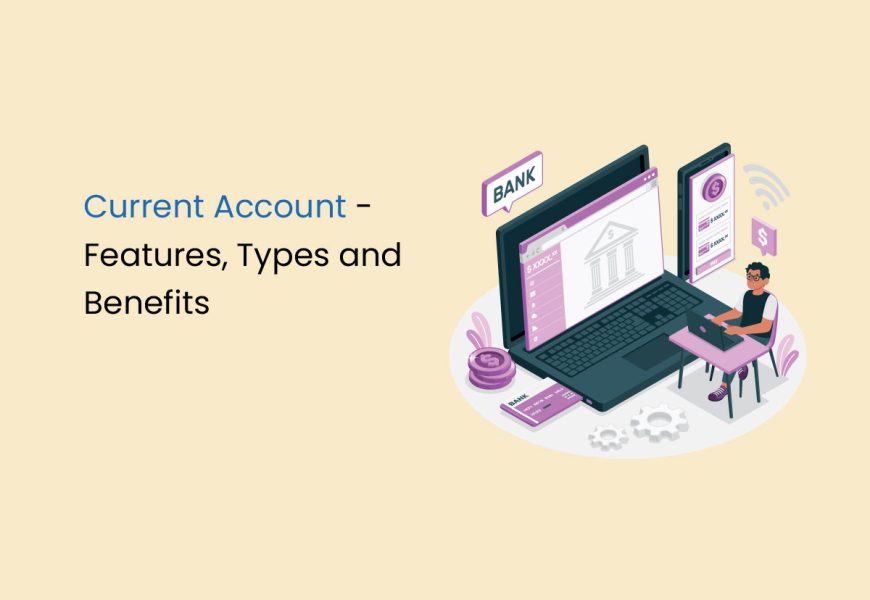When it comes to business finance, having a reliable current account is essential. It keeps personal and business finances separate, making tracking expenses, monitoring cash flow, and managing taxes easier. To choose the right type of current account, it is important to consider fees, interest rates, banking facilities, customer support, bank reputation, and online banking security.
This blog delves into current accounts, their features, benefits and types.
What is a Current Account?
Current accounts are bank accounts that businesses use to manage their day-to-day finances. They don’t earn interest, and business owners and corporations often use them. Business current accounts are designed to meet the financial needs of companies, partnerships, sole traders, and other types of organisations. They are the central hub for managing finances, handling incoming and outgoing payments, processing transactions, and maintaining liquidity. Unlike personal current accounts, which are meant for individual use, business current accounts offer financial solutions that cater to the specific needs of organisations.
Recent digitisation has made banking easier. The rise of digital-only banks has made it possible to open a current account from home. These accounts have many customised features, including payroll, corporate credit cards, and integrated vendor payments.
Features of Current Accounts
A current account offers the following features:
- Transaction Amount: Opening a current account becomes essential upon starting a registered business. One of its primary functions is accommodating transactions that surpass the imposed limits typically found in savings accounts. This is especially important for businesses dealing with large amounts of money, as it ensures that the financial transactions are processed smoothly and efficiently.
- Minimum Balance: The minimum balance requirement for a current account is typically higher than that for a savings account. This minimum balance is the lowest amount of money the account holder must maintain to avoid certain penalties or fines. The requirement can vary depending on the bank and the type of current account. However, failure to maintain this balance can result in penalties or fines for the account holder.
- Different Account Holder: A current account can be opened and used by various entities such as individuals, partners, public and private companies, associations and trusts. Each entity may have specific requirements and documents needed to use this account. The terms and conditions of the account may also differ depending on the entity and the financial institution providing the service.
- Unlimited Transaction: Different current accounts offer varying transaction limits. Some accounts, however, offer unlimited transactions, which means one can make as many transactions as they need in a day without any extra fees or charges. This is useful for people or businesses who require multiple transactions without worrying about exceeding limits.
- Smooth Transaction: Small business owners and entrepreneurs use current accounts to process their daily transactions smoothly. However, businesses can only have one current account registered under their name. Business owners must manage their finances carefully and ensure enough funds in their accounts to meet their daily business needs.
- Internet/Mobile Banking: Small business owners with a current account can easily access Internet and mobile banking. These services enable them to check balances, make payments, transfer funds, and schedule appointments with bank representatives. Internet banking lets them manage finances from anywhere, while mobile banking allows transactions on the go.
- Overdraft Facility: This feature allows the account holder to withdraw more money than what is available in their account up to a pre-approved limit. The overdraft facility can come in handy during financial emergencies or when the account holder needs to make a large purchase. However, this facility comes with an interest rate and additional fees, which will be charged on the overdrawn amount.
- Short-Term Funds Available: Small businesses with a current account can borrow short-term funds. These funds can be borrowed for a limited period and help cover unexpected expenses, pay bills, or fund small projects. However, the account holder must pay interest on the borrowed money. The interest rate may vary occasionally, depending on the market conditions and the bank’s policies.
Types of Current Account
The following are the various types of current accounts:
- Basic Current Account: A basic current account is a simple, affordable banking option suitable for startups or small businesses with minimal transaction volume. These accounts provide essential services like online banking and cheque facilities. They are low-cost and have minimal fees, making them a popular choice for businesses that want to keep their expenses low. Basic current accounts may not offer advanced features. Still, they provide the basic functionality most small businesses need to manage their finances.
- Regular Current Account: A regular current account is an upgraded version of a basic account. This type of account is best for businesses with moderate transaction needs that have been operating for a while. It has benefits like online banking, overdraft facilities, and better interest rates than basic accounts. It suits businesses requiring more comprehensive banking services. It is an upgrade from a basic account and offers higher transaction limits. The account is easy to manage, and companies can make more monthly transactions.
- Premium Current Account: A Premium Current Account is an option for businesses with complex financial needs and high transaction volumes. It offers exclusive features that cater to the unique requirements of such businesses, such as personalised assistance from a dedicated relationship manager, fast customer service, and free international transactions. Another advantage of a premium current account is that it often includes free international transactions, which is a significant cost-saver for businesses that engage in overseas trade.
- Foreign Currency Current Account: Foreign currency current accounts are specifically designed for businesses that frequently conduct international transactions. With these accounts, businesses can hold and manage funds in multiple foreign currencies, making it easier to conduct transactions across borders. However, there may be fees associated with currency exchange and international payments. These fees can vary depending on the bank or financial institution. To make an informed decision, it’s always a good idea to compare rates and fees before opening a foreign currency current account.
- Cash Management Current Account: Cash management current accounts are meant for businesses that want to manage their cash flow efficiently. This account has several features that help businesses streamline their financial operations. A key feature is the ability to automate collections, which makes payment processing easier and reduces errors. Another feature is account aggregation, allowing businesses to see all their accounts in one place, making tracking cash flow and transactions easier. Advanced reporting features also provide detailed financial performance insights for businesses to make informed decisions and optimise their cash management strategies.
- Trade Current Account: Trade current accounts are specialised accounts that cater to the needs of businesses engaged in import and export activities. They offer a wide range of trade finance solutions that assist businesses in managing their international transactions more effectively. These solutions may include letters of credit and documentary collections. These accounts provide a convenient and cost-effective way for businesses to manage their international trade transactions while minimising risks and maximising profits.
Current Account vs. Capital Account
In some countries, the capital account is divided into two main divisions: financial and capital accounts. The financial account tracks changes in international ownership of assets, while the capital account monitors financial transactions that do not impact income, production, or savings.
Benefits of Current Account
The benefits of a current account are as follows:
- Large Payments: When a business owner opens a current account, they gain the ability to receive or pay large volumes of cash systematically. This means the account allows for the streamlined and efficient processing of significant financial transactions. Whether accepting client payments or making large business purchases, a current account can provide the necessary infrastructure for efficiently handling such transactions. Additionally, the account holder can enjoy the convenience of electronic transactions and online banking, simplifying managing large payments.
- Unlimited Withdrawals: Account holders can make unlimited withdrawals without restrictions on the number of transactions they can perform. However, fees may apply to cash transactions. While there is no limit on the number of withdrawals that can be made, there may be additional charges for each cash transaction carried out. Therefore, account holders should check with their bank regarding any fees or charges associated with their accounts before making any withdrawals.
- High Accessibility: Current accounts allow account holders to access their accounts from any location other than the bank’s home branch. It is convenient for account holders who need to access their accounts frequently while travelling or away from their home branch. Customers may be required to pay a nominal charge to deposit cash into their current account from another location. This charge covers the costs incurred by the bank in processing and handling the deposit.
- Easy Transaction: A current account benefits businesses and individuals who have frequent transactions and need a reliable and efficient payment method. With a current account, account holders can easily transfer funds to other accounts, issue payment cheques, and request demand drafts for larger transactions. This type of account also offers overdraft facilities, where one can withdraw more than one’s current balance, subject to certain terms and conditions.
- Additional Benefits: Current accounts have various benefits that help businesses manage their finances more efficiently. This account enables convenient cash deposit and withdrawal from any location, facilitating smoother cash flow management. Furthermore, companies can receive free inward remittances, reducing costs associated with international transactions. Additionally, the ability to conduct multi-location transfers simplifies fund movement between different accounts. Opening a current account is a worthwhile consideration for businesses that have yet to do so.
- Easy Opening: When an individual wishes to open a current account, they must adhere to the banking institution’s KYC (Know Your Customer) guidelines. This typically involves providing personal identification documents such as a passport, driver’s license, or national ID card, along with proof of address such as a utility bill or bank statement.
- Gives Credit Knowledge: Current accounts help creditors evaluate the account holder’s financial situation. Banks and financial institutions have connections that allow creditors to access the account holder’s transaction history and other financial data. This helps creditors determine whether the account holder is eligible for credit, such as a loan or a credit card.
How to Open a Current Account Online?
Here are the steps for opening a current account online:
- Step 1: Visit the website of a registered bank and download the form to open a current account.
- Step 2: Accurately complete all the required fields for personal information, bank account details and other necessary sections.
- Step 3: After completing the form, please remember to take a printout of the current account application.
- Step 4: After completing the form, go to the nearest bank branch to submit it along with the required KYC documents.
In addition to using the online method, one can obtain the form by visiting the nearest bank branch and submitting it to the relevant department.
Documents Required to Open a Current Account
The documents to open a current account are as follows:
- Individual PAN Card / Business PAN Card
- Address proof (Voter ID, Aadhaar card, Ration card, etc.)
- An agreement must be submitted along with a copy of each partner’s ID and residential proof in the case of a partnership firm.
- Current account holders of companies or trusts must provide their Memorandum of Association (MoA) or certificate of incorporation.
- An agreement for a partnership firm requires submitting each partner’s ID and residential proof.
- Evidence of the company’s communication address if the current account holder is a company.
- A savings account cheque that can be used to open a current account
- The most recent passport-sized photographs of the nominees
The documents needed for a business may vary depending on the type.
Conclusion
A business current account is essential for managing finances, facilitating transactions, and supporting a business’s growth and success. By understanding the purpose, features, benefits, and considerations in choosing the right account, a business can make informed decisions that align with its goals and financial needs.
Frequently Asked Questions
What is the difference between current and capital accounts?
Current and capital accounts are two financial statements that serve different purposes. The current account shows a company's or partnership's net income. In contrast, the capital account shows the total change in ownership of national assets over a year.
What is the difference between a current and savings account?
A savings account is ideal for individuals with a steady monthly income, such as salaried employees, as it typically offers a 4% interest rate. On the other hand, current accounts are best suited for traders and entrepreneurs who require access to their funds but do not earn interest.
What is Balance of Payment?
The balance of payment is a statement that records all transactions between parties, including governments, individuals, and companies. This statement demonstrates the flow of funds.
Do current accounts have any charges?
Current account charges include non-maintenance charges, bulk transaction charges, collection charges, and bounced cheque charges, which vary depending on the type of account.
What is current account vs savings account?
A savings account is suitable for those who receive a monthly income, such as salaried employees. On the other hand, current accounts are more suitable for entrepreneurs and traders who need to access their funds frequently. Savings accounts usually earn interest of around 4%, while current accounts do not earn any interest.
What is the minimum balance in a current account?
Banks mandate a minimum account balance for Current Account holders. For instance, HDFC Bank requires Rs 10,000 for a regular Current Account.
What is the current account limit?
Banks limit the monthly deposit amount for Current Accounts instead of daily or yearly cash deposit limits. Current Accounts ' monthly free cash deposit limits may vary from ₹2 lakh to ₹3 crore, depending on business needs.














